Music Streaming Market Size 2025-2029
The music streaming market size is valued to increase USD 53.49 billion, at a CAGR of 19% from 2024 to 2029. Increasing preference for music streaming services will drive the music streaming market.
Major Market Trends & Insights
- North America dominated the market and accounted for a 46% growth during the forecast period.
- By Type - Free segment was valued at USD 16.80 billion in 2023
- By End-user - Individual users segment accounted for the largest market revenue share in 2023
Market Size & Forecast
- Market Opportunities: USD 282.20 billion
- Market Future Opportunities: USD 53.49 billion
- CAGR from 2024 to 2029 : 19%
Market Summary
- The market represents a dynamic and continually evolving industry, driven by the increasing preference for on-demand music access and the proliferation of differentiated streaming services. According to recent data, music streaming now accounts for over 75% of the global recorded music industry's revenue growth. This shift is fueled by the convenience and affordability of streaming services, which offer vast libraries and personalized recommendations.
- However, the market also faces challenges, including the lack of ownership in music streaming and ongoing regulatory issues. For instance, copyright disputes and licensing agreements continue to shape the industry landscape. Despite these challenges, opportunities abound, particularly in emerging markets and innovative technologies such as AI-driven music recommendations and virtual reality concerts.
What will be the Size of the Music Streaming Market during the forecast period?
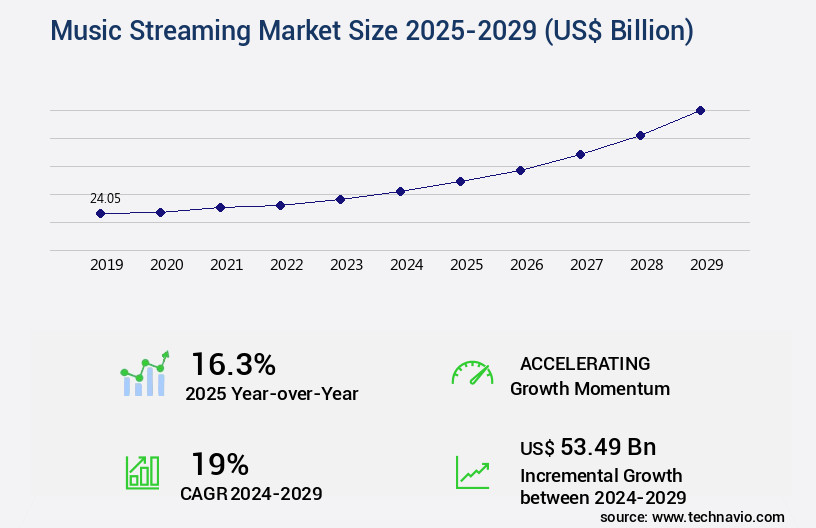
Get Key Insights on Market Forecast (PDF) Request Free Sample
How is the Music Streaming Market Segmented ?
The music streaming industry research report provides comprehensive data (region-wise segment analysis), with forecasts and estimates in "USD billion" for the period 2025-2029, as well as historical data from 2019-2023 for the following segments.
- Type
- End-user
- Individual users
- Commercial users
- Geography
- North America
- Europe
- Middle East and Africa
- APAC
- South America
- Rest of World (ROW)
By Type Insights
The free segment is estimated to witness significant growth during the forecast period.
The market is a dynamic and evolving landscape, characterized by advancements in audio signal processing, streaming protocols, and real-time analytics. User authentication protocols ensure secure access to streaming services, while server-side rendering and spatial audio rendering enhance the user experience. Content moderation systems and streaming analytics dashboards facilitate effective content management and user behavior analysis. Key market trends include the integration of digital rights management, personalized playlists, and adaptive bitrate streaming. Royalty distribution systems enable fair compensation to artists and copyright holders. User interface design focuses on low-latency streaming, offline playback features, and API integrations. Fraud detection systems and social features integration add layers of security and engagement.
Music discovery algorithms and recommendation engines are crucial for user experience metrics, while data encryption methods protect user data. High-fidelity audio and interactive music experiences are driving innovation. Cloud-based infrastructure, content delivery networks, and audio compression algorithms optimize streaming efficiency. The market for music streaming is expanding, with free music streaming services experiencing moderate growth. Free streaming is an ad-supported model, with leading providers like Spotify and Alphabet earning revenue through ads and in-app purchases. However, free subscriptions offer limited access to music and are interspersed with advertisements. The future of music streaming holds promising prospects, with expectations of significant growth in the premium segment.
Premium subscriptions offer uninterrupted, ad-free streaming and expanded access to music libraries. The integration of advanced technologies, such as lossless audio codecs and dynamic adaptive streaming, will further enhance the user experience. The market is a burgeoning industry, with continuous innovation and applications across various sectors. The ongoing unfolding of market activities and evolving patterns underscore its importance and potential for future growth.
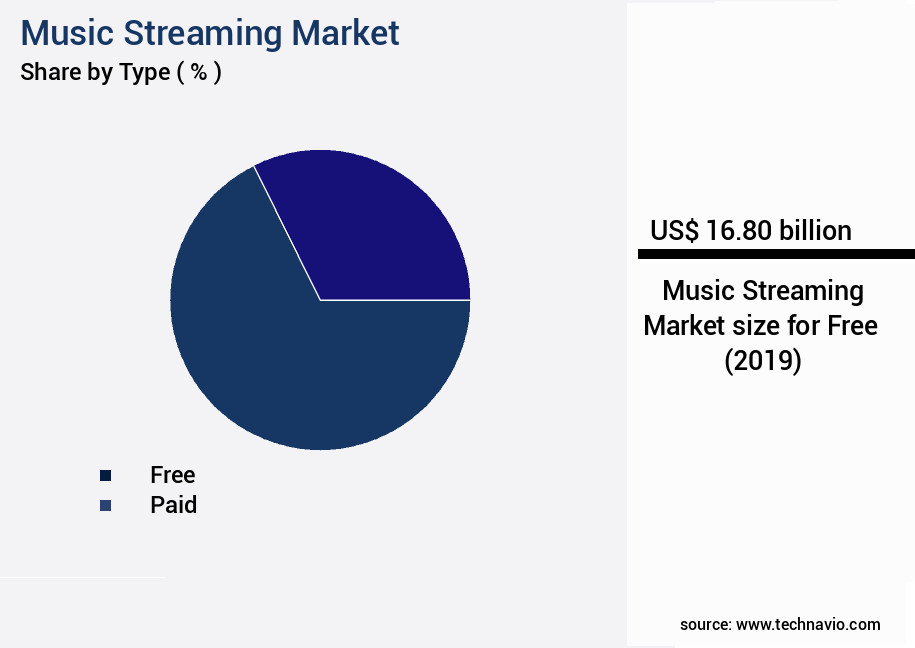
Request Free Sample
The Free segment was valued at USD 16.80 billion in 2019 and showed a gradual increase during the forecast period.
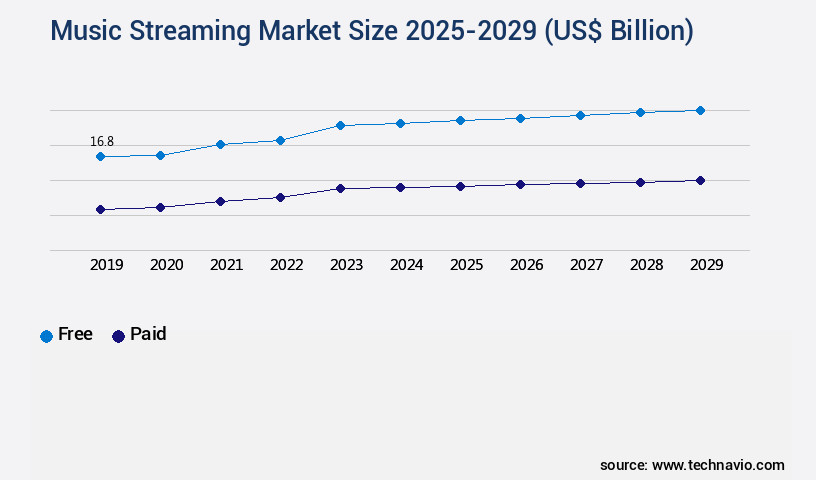
Request Free Sample
Regional Analysis
North America is estimated to contribute 46% to the growth of the global market during the forecast period.Technavio’s analysts have elaborately explained the regional trends and drivers that shape the market during the forecast period.
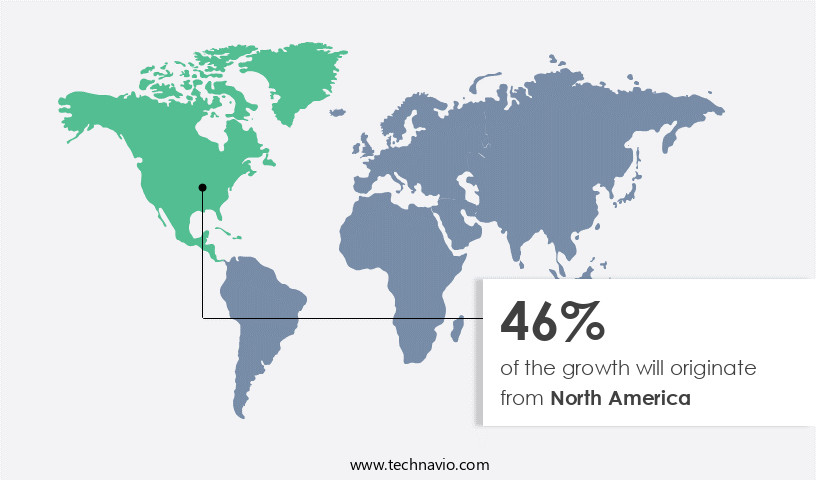
See How Music Streaming Market Demand is Rising in North America Request Free Sample
The market in North America is experiencing a shift in growth dynamics. With the US, a major market in the region, approaching saturation, expansion is predicted to slow down during the forecast period. The US market's saturation is attributed to its early adoption of music streaming services, which has resulted in a substantial subscriber base for music streaming providers. This growth has led to a decline in the demand for physical music components, such as compact discs (CDs), in the country.
Despite the slowing growth, the music streaming services market continues to thrive, driven by the large and loyal subscriber base.
Market Dynamics
Our researchers analyzed the data with 2024 as the base year, along with the key drivers, trends, and challenges. A holistic analysis of drivers will help companies refine their marketing strategies to gain a competitive advantage.
The market is a dynamic and evolving industry that continues to shape the way consumers access and enjoy music. One of the key factors driving market growth is the ongoing advancements in streaming technology. The effectiveness of different Digital Rights Management (DRM) implementations and the impact of audio compression on streaming quality are critical considerations for music streaming services. Optimization of adaptive bitrate streaming for mobile devices is essential to ensure a seamless user experience, given the varying network conditions that can significantly affect audio quality. Real-time analytics and user listening habits analysis are crucial for generating personalized playlists and improving overall engagement.
Scalability and reliability are essential aspects of music streaming infrastructure design, as the market deals with managing large music catalogs and handling increasing user demands. High-fidelity streaming requires the evaluation of various audio codecs, while personalized music recommendation systems and social features are integral to user experience. Strategies for music licensing and royalty distribution, as well as methods for improving user experience in mobile music streaming apps, are essential for market success. Techniques for enhancing audio quality in low-bandwidth environments and addressing challenges of managing large music catalogs are ongoing priorities. Security measures to protect against unauthorized access and the development of robust content moderation systems are essential for maintaining trust and user satisfaction.
Reducing buffering and latency and increasing user engagement through innovative features are key differentiators for market players. A significant portion of new product developments in the market focus on enhancing the user interface design to facilitate easy discovery and interaction with music content. The impact of different pricing models on music streaming revenue is a critical business consideration. Adoption rates for premium music streaming services are notably higher in developed regions compared to developing markets, with premium subscribers accounting for over 60% of the total revenue in the industry. This disparity underscores the importance of catering to diverse user needs and market conditions.
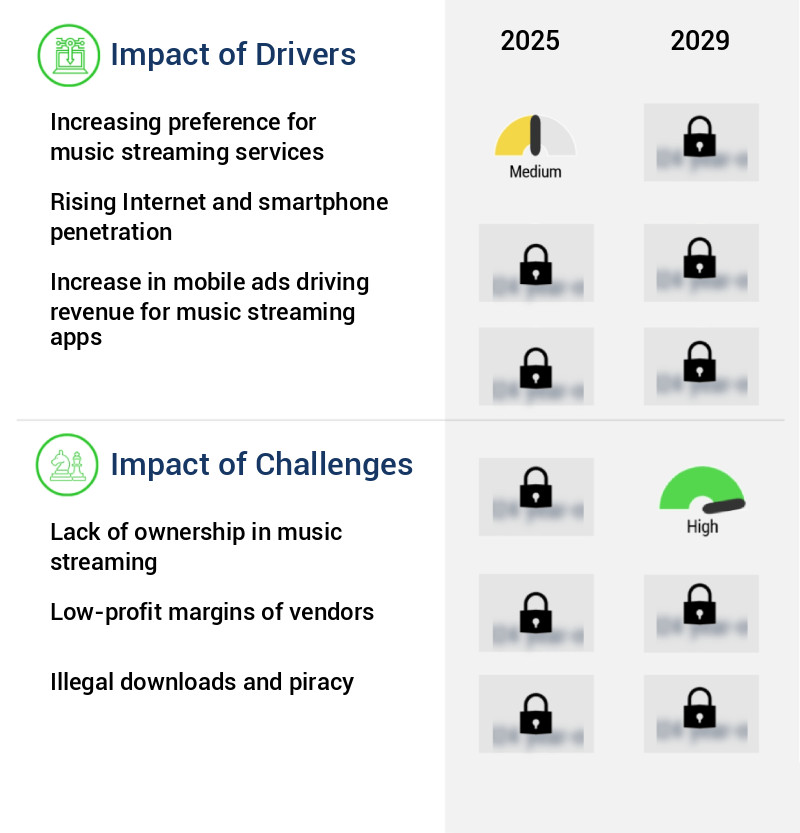
What are the key market drivers leading to the rise in the adoption of Music Streaming Industry?
- The significant shift in consumer preference towards music streaming services is the primary market driver, accounting for its ongoing growth.
- The market experiences continuous growth, with approximately 12 million new subscribers joining monthly. This trend is attributed to the advancement of wired and wireless technologies, including 3G, 4G, and 5G, which enhance Internet bandwidth and facilitate music streaming accessibility worldwide. Music streaming services have gained popularity due to their convenience and ability to prevent illegal music downloading and sharing. A significant portion of subscribers falls within the age group of 18-40 years.
- Young consumers prefer free music platforms like YouTube from Alphabet and free streaming services such as Spotify and Pandora from Sirius XM Holdings. This demographic shift underscores the evolving music consumption patterns and the increasing preference for on-demand, ad-supported music services.
What are the market trends shaping the Music Streaming Industry?
- The rising prevalence of specialized music streaming services represents a significant market trend.
This trend is characterized by an increasing number of platforms offering customized music experiences to consumers.
- In the dynamic global the market, major companies like YouTube Music, Pandora, Spotify, Deezer, and Tidal are introducing distinctive services to cater to evolving consumer preferences. These companies provide access to their streaming platforms across various devices and offer customized playlists and high-quality audio. For example, YouTube Music, an Alphabet product, and Pandora leverage user data from Google accounts and AI technology to deliver personalized song recommendations.
- This differentiates them from competitors, as they tailor content to individual listeners. The market continues to grow and adapt, with companies focusing on enhancing user experience and providing unique features to attract and retain subscribers.
What challenges does the Music Streaming Industry face during its growth?
- The absence of clear ownership and licensing structures in music streaming is a significant challenge impeding the industry's growth.
- The market represents a significant segment of the music publishing industry, characterized by its subscription-based business model. Unlike traditional music ownership models, this market allows consumers to access vast collections of songs without owning the music outright. A key challenge for music streaming services is the absence of ownership rights, which may deter potential subscribers. Moreover, the requirement for an internet connection to stream music adds an additional constraint. Despite these hurdles, the market continues to evolve, driven by advancements in technology and increasing consumer preferences for on-demand music access.
- The shift towards streaming services has led to a notable increase in the number of subscribers and the adoption of music streaming across various sectors, including education, healthcare, and hospitality. The market's continuous growth is indicative of its potential to transform the music industry landscape.
Exclusive Technavio Analysis on Customer Landscape
The music streaming market forecasting report includes the adoption lifecycle of the market, covering from the innovator’s stage to the laggard’s stage. It focuses on adoption rates in different regions based on penetration. Furthermore, the music streaming market report also includes key purchase criteria and drivers of price sensitivity to help companies evaluate and develop their market growth analysis strategies.
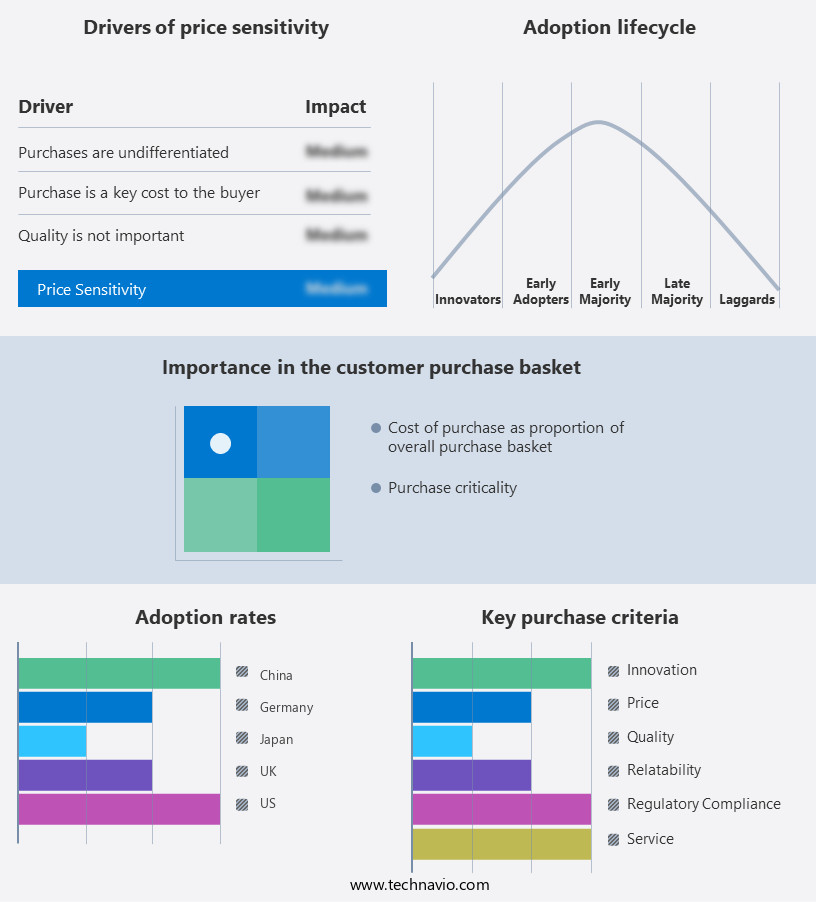
Customer Landscape of Music Streaming Industry
Competitive Landscape
Companies are implementing various strategies, such as strategic alliances, music streaming market forecast, partnerships, mergers and acquisitions, geographical expansion, and product/service launches, to enhance their presence in the industry.
Amazon.com Inc. - The Amazon Prime music app grants users unlimited access to a vast catalog of approximately 100 million songs. This on-demand music streaming service allows subscribers to explore a diverse range of genres and artists, enhancing their musical experience.
The industry research and growth report includes detailed analyses of the competitive landscape of the market and information about key companies, including:
- Amazon.com Inc.
- Apple Inc.
- Bharti Airtel Ltd.
- Curb Records Inc.
- Deezer SA
- Gamma Gaana Ltd.
- Google LLC
- iHeartMedia Inc.
- JioSaavn
- KKBOX
- Meredith Corp.
- Mixcloud Ltd.
- RealNetworks Inc.
- Sirius XM Holdings Inc.
- SoundCloud Global Ltd. and Co. KG
- SOUNDMACHINE
- Soundtrack Your Brand Sweden AB
- Spotify Technology SA
- Tencent Holdings Ltd.
- TuneIn Inc.
Qualitative and quantitative analysis of companies has been conducted to help clients understand the wider business environment as well as the strengths and weaknesses of key industry players. Data is qualitatively analyzed to categorize companies as pure play, category-focused, industry-focused, and diversified; it is quantitatively analyzed to categorize companies as dominant, leading, strong, tentative, and weak.
Recent Development and News in Music Streaming Market
- In January 2024, Spotify, the leading music streaming platform, announced the launch of its HiFi tier, offering lossless audio streaming and high-resolution sound quality for an additional subscription fee (Spotify Press Release, 2024). In March 2024, Apple Music and Amazon Music entered into a strategic partnership, allowing Amazon Music subscribers to access Apple Music's catalog and vice versa, expanding their collective offerings and enhancing user experience (Apple, 2024; Amazon, 2024).
- In May 2024, Tencent Music Entertainment, the Chinese music streaming giant, raised USD1.1 billion through an equity offering, further strengthening its financial position and enabling potential acquisitions or strategic investments (Reuters, 2024). In February 2025, Deezer, a major music streaming platform, secured a partnership with the European Broadcasting Union (EBU), allowing Deezer to offer live radio streams from over 60 European public broadcasters, expanding its content library and catering to a broader audience (Deezer, 2025).
Dive into Technavio’s robust research methodology, blending expert interviews, extensive data synthesis, and validated models for unparalleled Music Streaming Market insights. See full methodology.
|
Market Scope
|
|
Report Coverage
|
Details
|
|
Page number
|
194
|
|
Base year
|
2024
|
|
Historic period
|
2019-2023 |
|
Forecast period
|
2025-2029
|
|
Growth momentum & CAGR
|
Accelerate at a CAGR of 19%
|
|
Market growth 2025-2029
|
USD 53.49 billion
|
|
Market structure
|
Fragmented
|
|
YoY growth 2024-2025(%)
|
16.3
|
|
Key countries
|
US, China, UK, Germany, Canada, Japan, Brazil, France, India, and UAE
|
|
Competitive landscape
|
Leading Companies, Market Positioning of Companies, Competitive Strategies, and Industry Risks
|
Request Free Sample
Research Analyst Overview
- In the dynamic and evolving the market, audio signal processing plays a pivotal role in delivering high-quality listening experiences. Real-time analytics and user authentication protocols ensure seamless access to streaming services, while server-side rendering optimizes content delivery. User listening behavior is a critical factor influencing market activities, with streaming analytics dashboards providing valuable insights into consumer preferences. Content moderation systems and metadata tagging standards maintain the quality and appropriateness of the vast music libraries available. Playlist generation algorithms and personalized recommendations cater to individual tastes, while adaptive bitrate streaming ensures uninterrupted playback in various network conditions. Royalty distribution systems and digital rights management address the complexities of music licensing agreements.
- User interface design, low-latency streaming, and offline playback features enhance user experience, with API integrations facilitating seamless third-party partnerships. Fraud detection systems and social features integration further enrich the music streaming experience. Music discovery algorithms, user experience metrics, data encryption methods, and high-fidelity audio contribute to the ongoing innovation in this market. Interactive music experiences, cloud-based infrastructure, recommendation engines, content delivery networks, and audio compression algorithms are essential components of the advanced technology stack underpinning music streaming services. Spatial audio rendering and dynamic adaptive streaming are emerging trends, offering immersive listening experiences and optimizing bandwidth usage, respectively.
- Scalable architecture design and lossless audio codecs ensure the long-term viability and growth of the market, as it continues to evolve and adapt to the ever-changing needs and preferences of consumers.
What are the Key Data Covered in this Music Streaming Market Research and Growth Report?
-
What is the expected growth of the Music Streaming Market between 2025 and 2029?
-
What segmentation does the market report cover?
-
The report is segmented by Type (Free and Paid), End-user (Individual users and Commercial users), and Geography (North America, Europe, APAC, South America, and Middle East and Africa)
-
Which regions are analyzed in the report?
-
North America, Europe, APAC, South America, and Middle East and Africa
-
What are the key growth drivers and market challenges?
-
Who are the major players in the Music Streaming Market?
-
Amazon.com Inc., Apple Inc., Bharti Airtel Ltd., Curb Records Inc., Deezer SA, Gamma Gaana Ltd., Google LLC, iHeartMedia Inc., JioSaavn, KKBOX, Meredith Corp., Mixcloud Ltd., RealNetworks Inc., Sirius XM Holdings Inc., SoundCloud Global Ltd. and Co. KG, SOUNDMACHINE, Soundtrack Your Brand Sweden AB, Spotify Technology SA, Tencent Holdings Ltd., and TuneIn Inc.
Market Research Insights
- The market continues to evolve, with over 420 million users worldwide as of 2021, representing a 20% annual growth rate. Two key aspects driving market expansion are advanced technologies and user experience enhancements. Secure payment gateways and buffering optimization ensure seamless transactions and uninterrupted playback. Audio encoding techniques and content caching strategies improve streaming quality, while user engagement metrics and account management systems cater to subscriber needs. Playback latency remains a critical concern, with industry leaders investing in artist royalty payments and music catalog management to maintain a competitive edge. Software development lifecycle, compliance regulations, and data analytics platforms enable continuous improvement, while testing frameworks and data privacy compliance safeguard user trust.
- Personalization algorithms, advertising revenue models, and monetization strategies expand revenue streams, and community features, mobile app development, and social media integration foster user engagement. Network bandwidth impact and DRM technologies are ongoing challenges, requiring scalability solutions and copyright management.
We can help! Our analysts can customize this music streaming market research report to meet your requirements.
Get in touch
1 Executive Summary
- 1.1 Market overview
- Executive Summary - Chart on Market Overview
- Executive Summary - Data Table on Market Overview
- Executive Summary - Chart on Global Market Characteristics
- Executive Summary - Chart on Market by Geography
- Executive Summary - Chart on Market Segmentation by Type
- Executive Summary - Chart on Market Segmentation by End-user
- Executive Summary - Chart on Incremental Growth
- Executive Summary - Data Table on Incremental Growth
- Executive Summary - Chart on Company Market Positioning
2 Technavio Analysis
- 2.1 Analysis of price sensitivity, lifecycle, customer purchase basket, adoption rates, and purchase criteria
- Analysis of price sensitivity, lifecycle, customer purchase basket, adoption rates, and purchase criteria
- 2.2 Criticality of inputs and Factors of differentiation
- Overview on criticality of inputs and factors of differentiation
- 2.3 Factors of disruption
- Overview on factors of disruption
- 2.4 Impact of drivers and challenges
- Impact of drivers and challenges in 2024 and 2029
3 Market Landscape
- 3.1 Market ecosystem
- Parent Market
- Data Table on - Parent Market
- 3.2 Market characteristics
- Market characteristics analysis
4 Market Sizing
- 4.1 Market definition
- Offerings of companies included in the market definition
- 4.2 Market segment analysis
- 4.4 Market outlook: Forecast for 2024-2029
- Chart on Global - Market size and forecast 2024-2029 ($ billion)
- Data Table on Global - Market size and forecast 2024-2029 ($ billion)
- Chart on Global Market: Year-over-year growth 2024-2029 (%)
- Data Table on Global Market: Year-over-year growth 2024-2029 (%)
5 Historic Market Size
- 5.1 Global Music Streaming Market 2019 - 2023
- Historic Market Size - Data Table on Global Music Streaming Market 2019 - 2023 ($ billion)
- 5.2 Type segment analysis 2019 - 2023
- Historic Market Size - Type Segment 2019 - 2023 ($ billion)
- 5.3 End-user segment analysis 2019 - 2023
- Historic Market Size - End-user Segment 2019 - 2023 ($ billion)
- 5.4 Geography segment analysis 2019 - 2023
- Historic Market Size - Geography Segment 2019 - 2023 ($ billion)
- 5.5 Country segment analysis 2019 - 2023
- Historic Market Size - Country Segment 2019 - 2023 ($ billion)
6 Qualitative Analysis
- 6.1 AI Impact on Global Music Streaming Market
7 Five Forces Analysis
- 7.1 Five forces summary
- Five forces analysis - Comparison between 2024 and 2029
- 7.2 Bargaining power of buyers
- Bargaining power of buyers - Impact of key factors 2024 and 2029
- 7.3 Bargaining power of suppliers
- Bargaining power of suppliers - Impact of key factors in 2024 and 2029
- 7.4 Threat of new entrants
- Threat of new entrants - Impact of key factors in 2024 and 2029
- 7.5 Threat of substitutes
- Threat of substitutes - Impact of key factors in 2024 and 2029
- 7.6 Threat of rivalry
- Threat of rivalry - Impact of key factors in 2024 and 2029
- 7.7 Market condition
- Chart on Market condition - Five forces 2024 and 2029
8 Market Segmentation by Type
- 8.1 Market segments
- Chart on Type - Market share 2024-2029 (%)
- Data Table on Type - Market share 2024-2029 (%)
- 8.2 Comparison by Type
- Chart on Comparison by Type
- Data Table on Comparison by Type
- 8.3 Free - Market size and forecast 2024-2029
- Chart on Free - Market size and forecast 2024-2029 ($ billion)
- Data Table on Free - Market size and forecast 2024-2029 ($ billion)
- Chart on Free - Year-over-year growth 2024-2029 (%)
- Data Table on Free - Year-over-year growth 2024-2029 (%)
- 8.4 Paid - Market size and forecast 2024-2029
- Chart on Paid - Market size and forecast 2024-2029 ($ billion)
- Data Table on Paid - Market size and forecast 2024-2029 ($ billion)
- Chart on Paid - Year-over-year growth 2024-2029 (%)
- Data Table on Paid - Year-over-year growth 2024-2029 (%)
- 8.5 Market opportunity by Type
- Market opportunity by Type ($ billion)
- Data Table on Market opportunity by Type ($ billion)
9 Market Segmentation by End-user
- 9.1 Market segments
- Chart on End-user - Market share 2024-2029 (%)
- Data Table on End-user - Market share 2024-2029 (%)
- 9.2 Comparison by End-user
- Chart on Comparison by End-user
- Data Table on Comparison by End-user
- 9.3 Individual users - Market size and forecast 2024-2029
- Chart on Individual users - Market size and forecast 2024-2029 ($ billion)
- Data Table on Individual users - Market size and forecast 2024-2029 ($ billion)
- Chart on Individual users - Year-over-year growth 2024-2029 (%)
- Data Table on Individual users - Year-over-year growth 2024-2029 (%)
- 9.4 Commercial users - Market size and forecast 2024-2029
- Chart on Commercial users - Market size and forecast 2024-2029 ($ billion)
- Data Table on Commercial users - Market size and forecast 2024-2029 ($ billion)
- Chart on Commercial users - Year-over-year growth 2024-2029 (%)
- Data Table on Commercial users - Year-over-year growth 2024-2029 (%)
- 9.5 Market opportunity by End-user
- Market opportunity by End-user ($ billion)
- Data Table on Market opportunity by End-user ($ billion)
10 Customer Landscape
- 10.1 Customer landscape overview
- Analysis of price sensitivity, lifecycle, customer purchase basket, adoption rates, and purchase criteria
11 Geographic Landscape
- 11.1 Geographic segmentation
- Chart on Market share by geography 2024-2029 (%)
- Data Table on Market share by geography 2024-2029 (%)
- 11.2 Geographic comparison
- Chart on Geographic comparison
- Data Table on Geographic comparison
- 11.3 North America - Market size and forecast 2024-2029
- Chart on North America - Market size and forecast 2024-2029 ($ billion)
- Data Table on North America - Market size and forecast 2024-2029 ($ billion)
- Chart on North America - Year-over-year growth 2024-2029 (%)
- Data Table on North America - Year-over-year growth 2024-2029 (%)
- 11.4 Europe - Market size and forecast 2024-2029
- Chart on Europe - Market size and forecast 2024-2029 ($ billion)
- Data Table on Europe - Market size and forecast 2024-2029 ($ billion)
- Chart on Europe - Year-over-year growth 2024-2029 (%)
- Data Table on Europe - Year-over-year growth 2024-2029 (%)
- 11.5 APAC - Market size and forecast 2024-2029
- Chart on APAC - Market size and forecast 2024-2029 ($ billion)
- Data Table on APAC - Market size and forecast 2024-2029 ($ billion)
- Chart on APAC - Year-over-year growth 2024-2029 (%)
- Data Table on APAC - Year-over-year growth 2024-2029 (%)
- 11.6 South America - Market size and forecast 2024-2029
- Chart on South America - Market size and forecast 2024-2029 ($ billion)
- Data Table on South America - Market size and forecast 2024-2029 ($ billion)
- Chart on South America - Year-over-year growth 2024-2029 (%)
- Data Table on South America - Year-over-year growth 2024-2029 (%)
- 11.7 Middle East and Africa - Market size and forecast 2024-2029
- Chart on Middle East and Africa - Market size and forecast 2024-2029 ($ billion)
- Data Table on Middle East and Africa - Market size and forecast 2024-2029 ($ billion)
- Chart on Middle East and Africa - Year-over-year growth 2024-2029 (%)
- Data Table on Middle East and Africa - Year-over-year growth 2024-2029 (%)
- 11.8 US - Market size and forecast 2024-2029
- Chart on US - Market size and forecast 2024-2029 ($ billion)
- Data Table on US - Market size and forecast 2024-2029 ($ billion)
- Chart on US - Year-over-year growth 2024-2029 (%)
- Data Table on US - Year-over-year growth 2024-2029 (%)
- 11.9 China - Market size and forecast 2024-2029
- Chart on China - Market size and forecast 2024-2029 ($ billion)
- Data Table on China - Market size and forecast 2024-2029 ($ billion)
- Chart on China - Year-over-year growth 2024-2029 (%)
- Data Table on China - Year-over-year growth 2024-2029 (%)
- 11.10 UK - Market size and forecast 2024-2029
- Chart on UK - Market size and forecast 2024-2029 ($ billion)
- Data Table on UK - Market size and forecast 2024-2029 ($ billion)
- Chart on UK - Year-over-year growth 2024-2029 (%)
- Data Table on UK - Year-over-year growth 2024-2029 (%)
- 11.11 Canada - Market size and forecast 2024-2029
- Chart on Canada - Market size and forecast 2024-2029 ($ billion)
- Data Table on Canada - Market size and forecast 2024-2029 ($ billion)
- Chart on Canada - Year-over-year growth 2024-2029 (%)
- Data Table on Canada - Year-over-year growth 2024-2029 (%)
- 11.12 Germany - Market size and forecast 2024-2029
- Chart on Germany - Market size and forecast 2024-2029 ($ billion)
- Data Table on Germany - Market size and forecast 2024-2029 ($ billion)
- Chart on Germany - Year-over-year growth 2024-2029 (%)
- Data Table on Germany - Year-over-year growth 2024-2029 (%)
- 11.13 Japan - Market size and forecast 2024-2029
- Chart on Japan - Market size and forecast 2024-2029 ($ billion)
- Data Table on Japan - Market size and forecast 2024-2029 ($ billion)
- Chart on Japan - Year-over-year growth 2024-2029 (%)
- Data Table on Japan - Year-over-year growth 2024-2029 (%)
- 11.14 France - Market size and forecast 2024-2029
- Chart on France - Market size and forecast 2024-2029 ($ billion)
- Data Table on France - Market size and forecast 2024-2029 ($ billion)
- Chart on France - Year-over-year growth 2024-2029 (%)
- Data Table on France - Year-over-year growth 2024-2029 (%)
- 11.15 Brazil - Market size and forecast 2024-2029
- Chart on Brazil - Market size and forecast 2024-2029 ($ billion)
- Data Table on Brazil - Market size and forecast 2024-2029 ($ billion)
- Chart on Brazil - Year-over-year growth 2024-2029 (%)
- Data Table on Brazil - Year-over-year growth 2024-2029 (%)
- 11.16 India - Market size and forecast 2024-2029
- Chart on India - Market size and forecast 2024-2029 ($ billion)
- Data Table on India - Market size and forecast 2024-2029 ($ billion)
- Chart on India - Year-over-year growth 2024-2029 (%)
- Data Table on India - Year-over-year growth 2024-2029 (%)
- 11.17 UAE - Market size and forecast 2024-2029
- Chart on UAE - Market size and forecast 2024-2029 ($ billion)
- Data Table on UAE - Market size and forecast 2024-2029 ($ billion)
- Chart on UAE - Year-over-year growth 2024-2029 (%)
- Data Table on UAE - Year-over-year growth 2024-2029 (%)
- 11.18 Market opportunity by geography
- Market opportunity by geography ($ billion)
- Data Tables on Market opportunity by geography ($ billion)
12 Drivers, Challenges, and Opportunity/Restraints
- 12.3 Impact of drivers and challenges
- Impact of drivers and challenges in 2024 and 2029
- 12.4 Market opportunities/restraints
13 Competitive Landscape
- 13.2 Competitive Landscape
- Overview on criticality of inputs and factors of differentiation
- 13.3 Landscape disruption
- Overview on factors of disruption
- 13.4 Industry risks
- Impact of key risks on business
14 Competitive Analysis
- 14.2 Company ranking index
- 14.3 Market positioning of companies
- Matrix on companies position and classification
- 14.4 Amazon.com Inc.
- Amazon.com Inc. - Overview
- Amazon.com Inc. - Business segments
- Amazon.com Inc. - Key news
- Amazon.com Inc. - Key offerings
- Amazon.com Inc. - Segment focus
- SWOT
- 14.5 Apple Inc.
- Apple Inc. - Overview
- Apple Inc. - Business segments
- Apple Inc. - Key news
- Apple Inc. - Key offerings
- Apple Inc. - Segment focus
- SWOT
- 14.6 Bharti Airtel Ltd.
- Bharti Airtel Ltd. - Overview
- Bharti Airtel Ltd. - Business segments
- Bharti Airtel Ltd. - Key news
- Bharti Airtel Ltd. - Key offerings
- Bharti Airtel Ltd. - Segment focus
- SWOT
- 14.7 Curb Records Inc.
- Curb Records Inc. - Overview
- Curb Records Inc. - Product / Service
- Curb Records Inc. - Key offerings
- SWOT
- 14.8 Deezer SA
- Deezer SA - Overview
- Deezer SA - Product / Service
- Deezer SA - Key news
- Deezer SA - Key offerings
- SWOT
- 14.9 Gamma Gaana Ltd.
- Gamma Gaana Ltd. - Overview
- Gamma Gaana Ltd. - Product / Service
- Gamma Gaana Ltd. - Key offerings
- SWOT
- 14.10 Google LLC
- Google LLC - Overview
- Google LLC - Product / Service
- Google LLC - Key offerings
- SWOT
- 14.11 iHeartMedia Inc.
- iHeartMedia Inc. - Overview
- iHeartMedia Inc. - Business segments
- iHeartMedia Inc. - Key offerings
- iHeartMedia Inc. - Segment focus
- SWOT
- 14.12 JioSaavn
- JioSaavn - Overview
- JioSaavn - Product / Service
- JioSaavn - Key offerings
- SWOT
- 14.13 KKBOX
- KKBOX - Overview
- KKBOX - Product / Service
- KKBOX - Key offerings
- SWOT
- 14.14 Meredith Corp.
- Meredith Corp. - Overview
- Meredith Corp. - Product / Service
- Meredith Corp. - Key offerings
- SWOT
- 14.15 Sirius XM Holdings Inc.
- Sirius XM Holdings Inc. - Overview
- Sirius XM Holdings Inc. - Business segments
- Sirius XM Holdings Inc. - Key offerings
- Sirius XM Holdings Inc. - Segment focus
- SWOT
- 14.16 SoundCloud Global Ltd. and Co. KG
- SoundCloud Global Ltd. and Co. KG - Overview
- SoundCloud Global Ltd. and Co. KG - Product / Service
- SoundCloud Global Ltd. and Co. KG - Key offerings
- SWOT
- 14.17 Spotify Technology SA
- Spotify Technology SA - Overview
- Spotify Technology SA - Business segments
- Spotify Technology SA - Key offerings
- Spotify Technology SA - Segment focus
- SWOT
- 14.18 Tencent Holdings Ltd.
- Tencent Holdings Ltd. - Overview
- Tencent Holdings Ltd. - Business segments
- Tencent Holdings Ltd. - Key news
- Tencent Holdings Ltd. - Key offerings
- Tencent Holdings Ltd. - Segment focus
- SWOT
15 Appendix
- 15.2 Inclusions and exclusions checklist
- Inclusions checklist
- Exclusions checklist
- 15.3 Currency conversion rates for US$
- Currency conversion rates for US$
- 15.4 Research methodology
- 15.7 Validation techniques employed for market sizing
- Validation techniques employed for market sizing
- 15.9 360 degree market analysis
- 360 degree market analysis
- 15.10 List of abbreviations







![]() Get the report (PDF) sent to your email within minutes.
Get the report (PDF) sent to your email within minutes.
Complimentary full Excel data with your report purchase.